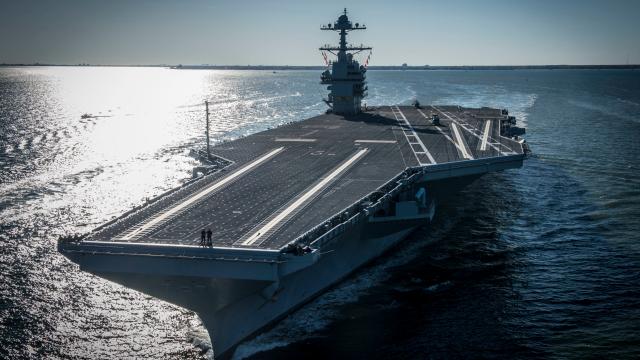Three years late and costing $US13 billion ($16 billion), the USS Gerald R. Ford has finally been commissioned at Norfolk Naval Station in Virginia. The latest aircraft carrier to join the American fleet has been burdened with — and this may shock you, considering we are talking about defence spending — cost overruns and significant delays. Despite being commissioned, it will be at least four years before the carrier will be able to deploy and truly become part of the fleet.
USS Gerald R Ford Arriving Naval Station Norfolk. US Navy Photo
Many challenges remain for the carrier as substantial amounts of construction and testing remains to be completed. In fact, one significant problem to be solved involves launching and recovering aircraft, which is the sole reason aircraft carriers exist.
All issues aside, the ship is a huge deal, a critical component in America’s defence future. Here’s what you should know about it.
Welcome To The Future
The Ford is the lead ship of new class of aircraft carriers, the first new variant since the Nimitz-class was introduced in 1975. Construction began on the Ford in 2005 and the ship was christened in 2013. As it currently stands the carrier will be the most expensive warship the United States has ever built.
Incorporating many significant changes over its predecessors, the Ford-class will have newly designed catapults and arresting gear, a redesigned and smaller island superstructure that is farther aft, a larger flight deck, new radar systems, quicker weapons elevators and 300 per cent more electrical capacity from newly designed nuclear reactors.
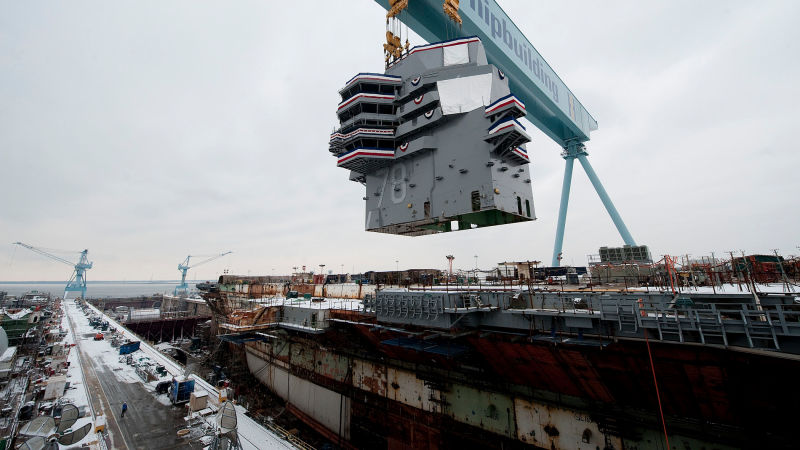
The problem is that many of these systems are immature and have not been able to perform up to expected levels. The San Diego Union-Tribune described the construction of the Ford as “a monument to the Navy’s and defence industry’s ability to justify spending billions on unproven technologies that often deliver worse performance at a higher cost.” Despite the lip service presented by Navy and industry officials, the construction of the Ford has been something of a disaster.
To be fair, no modern warship is ready to sail off to war the day after being commissioned. Tests need to be completed and the ships need to be put through their paces to discover any abnormalities or deficiencies that may not have been discovered during builder trials, when the ship is put to sea under the watchful eye of the company that constructed the ship.
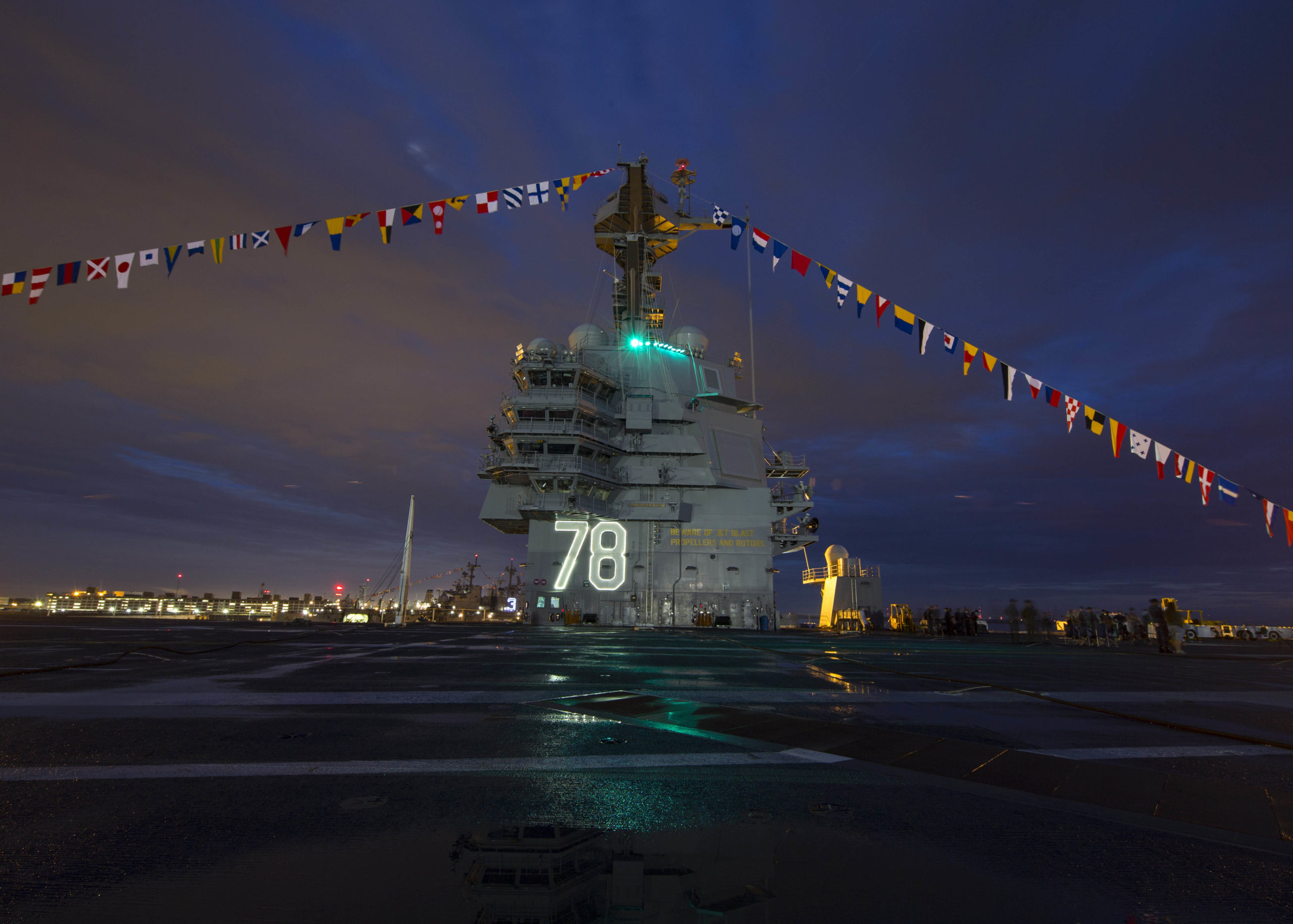
The resigned island of USS Gerald R Ford as the carrier awaits commissioning. US Navy Photo
The Ford is a special case, however. So many systems are deficient and remain unresolved that the Navy does not expect the carrier to reach IOC, or initial operational capability, until 2020 at the earliest.
Once commissioned it is expected the Navy will run the Ford through a series of tests between March and November of 2018. After that, it is hoped the Navy will put the carrier through full ship “shock trials”, though language placed in the House Armed Services Committee annual defence bill last month has given the Navy an out on conducting the test. Instead, trials would be conducted on USS John F Kennedy, the second carrier in the new class.
By skipping these tests on the Ford, Navy officials hope to make the carrier available sooner for overseas operations. It was reported back in late 2015 that conducting the tests would delay the carrier’s first deployment by two years as the Navy fixed what was broken.
More Money, More Problems
Two recent reports have highlighted the difficulties with the Ford, which is designated CVN 78. The first report was issued in December 2016. The Director, Operational Test and Evaluation (DTO&E) for the Department of Defence issued a stinging report that highlighted the many problems the ship was facing as it neared being delivered delivery.
Again, the issue here is all this unproven new tech. According to the report, “Poor or unknown reliability of the newly designed catapults, arresting gear, weapons elevators, and radar, which are critical for flight operations, could affect CVN 78’s ability to generate sorties, make the ship more vulnerable to attack, or create limitations during routine operations. The poor or unknown reliably of these critical subsystems is the most significant risk to CVN 78. Based on current reliably estimates, CVN 78 is unlikely to be able to conduct the type of high-intensity flight operations expected during wartime.”
Not exactly the description you would hope to read after spending almost $US13 billion to build an aircraft carrier.
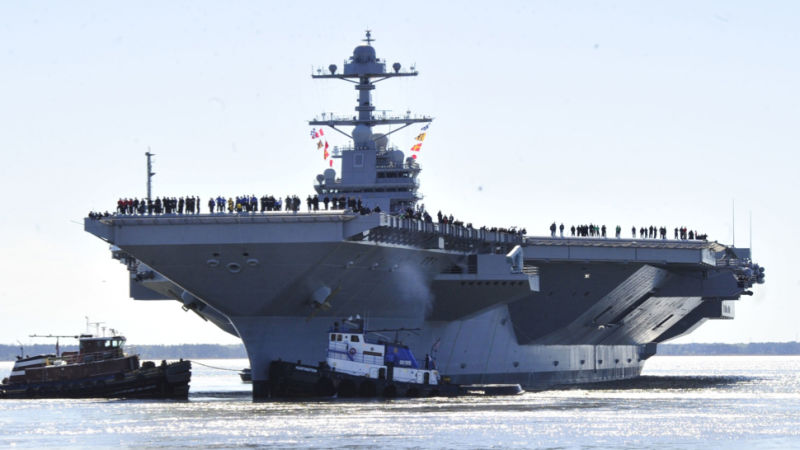
The second report that was released earlier this month by the Government Accountability Office, or GAO, on Navy Shipbuilding was another harsh rebuke of the Navy’s decision to accept the Ford “from the shipbuilder in incomplete condition.”
As it stands now, according to the GAO, the Navy will spend at least an additional $US779 million to complete construction of the ship and conduct tests that are required to validate the design. The GAO also echoed the earlier report in addressing the fact that the carrier will not have the necessary certifications to conduct aviation operations, navigation and cybersecurity protection and added that upon delivery the Ford will have “significant incomplete construction” where work on 367 compartments was deferred.
These compartments include crew berthing, food service areas and bathrooms.
The Trick Launch System Will Be Tricky
Of all the issues, the most obvious problem for the Ford is the current inability to launch fully loaded aircraft. For nearly 50 years, the Navy has relied on steam to power its catapults. Steam has proven reliable and efficient yet the Navy chose to replace the system, preferring to find a less maintenance intensive system. Less maintenance means fewer sailors needed to service the equipment which also means less cost to operate.
Even President Trump dove into the debate when he demanded that the Navy keep “goddamned steam” instead of the new system he was shown while on board the Ford, although that claim raised some eyebrows too.
The new catapult system is the Electromagnetic Aircraft Launch System, or EMALS. Built by General Atomics, who brought the world the Predator and Reaper drones, but has no experience in producing these items for carrier operations.
The project has struggled to find success since inception as issues were identified as far back as 2014. EMALS has not fared well, either in testing or on Capitol Hill. Jane’s reported that “U.S. lawmakers noted that the issue with the new catapult system had been previously described as a problem with ‘its ability to launch aircraft — particularly aircraft that have all their fuel tanks in place.”
According to the DOT&E report, problems exist when launching either F/A-18E/F Super Hornets or E/A-18G Growlers that are carrying wing-mounted fuel tanks and ordnance carried on wing stations. This means that the Ford is unable to launch fully-loaded combat aircraft from its deck, substantially reducing the combat effectiveness of the Super Hornet and Growler. Considering that the future air wing will consist of 30 Super Hornets and Growlers, that is an issue.
The problems have been identified as software related and fixes are believed to have been created, though full testing will not occur until later this year or early next year. EMALS was also designed to put less stress on the aircraft being launched, thereby increasing the lifespan of carrier aircraft. This has also not worked out as Hornet airframes have actually been overstressed during launch by EMALS.
Another huge concern with EMALS is the Mean Cycles Between Critical Failure (MCBCF), where the system will not work as advertised and subsequently not provide enough power to launch an aircraft from the deck — placing the crew in a quite precarious position.
Carrier flight operations are a zero-sum operation with very little room for error, and thus far EMALS has demonstrated 400 MCBCF. The requirement is 4,166 MCBCF, or 4,166 launches before the systems experiences a failure. EMALS is currently nowhere close to meeting that minimum standard.
A very real future concern with EMALS is the inability to isolate one catapult for maintenance during launch. For the proven steam catapult system currently used by American carriers, a single catapult of the four can be isolated to perform maintenance. This allows launch operations to continue should a catapult experience a mechanical issue. EMALS does not have the ability to isolate single catapults and performing maintenance will be time consuming and affect the entirety of flight operations as it currently stands.
According to the DOT&E report, just spinning down the EMALS motor-generators take 1.5 hours. Only then can any maintenance can begin, with no ability to conduct flight operations.
Ford was also designed to achieve a higher sortie rate, meaning it could launch more aircraft than the previous class of carriers. This is called the SGR, or Sortie Generation Rate. DOT&E has questioned the Navy’s requirements for achieving a successful SGR pointing out that during its calculations the Navy assumed fair weather, unlimited visibility and that issues such as aircraft emergencies, ship manoeuvring, and failure of shipboard equipment would not affect flight operations.
The problems do not limit themselves to launching aircraft. There’s also the new ship’s radar, the unrealistic manning expectations that have required more berthing to be installed and even the ship’s common computing system as well as the advanced arresting gear which has proved to be almost as troublesome as the catapult system.
Testing with the arresting gears have proven thus far that there are only 25 landings between operational mission failures. The Navy’s requirement is 16,500. The new arresting gears have also surged in price, with the original 2005 estimate of $US172 million now swelled to $US1.3 billion. And like the EMALS system, the arresting gear cannot undergo maintenance without temporarily terminating flight operations.
But Wait, There’s More
According to the GAO report, the Navy will accept the Ford with a large number of test, trials and areas of construction still to be completed. In fact, most of the new high speed and more capable advanced weapons elevators have yet to be installed.
Designed to transport weapons from their storage deep within the ship to the flight deck more rapidly, the weapons elevators were supposed to be a significant addition to the Ford. So far only two of the 11 have been installed with the other nine to be installed sometime after the ship is commissioned.
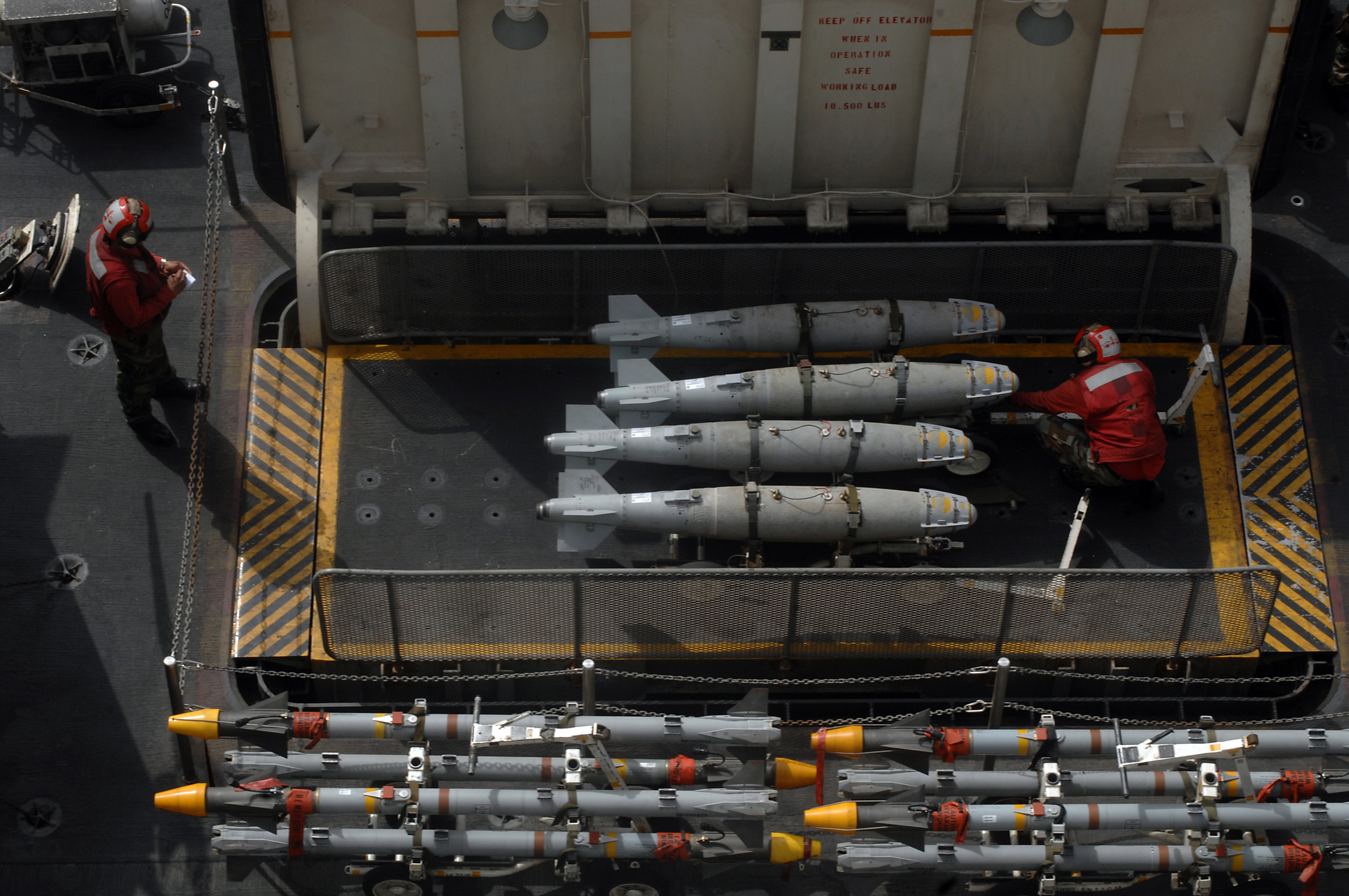
A Weapons Elevator aboard USS Harry S Truman. US Navy Photo
The Ford and the USS Zumwalt, or DDG 1000, are two highly technologically advanced ships, both first-in -class ships, that the Navy has taken a new approach on ship delivery, relying on waivers or exceptions to longstanding policy.
As a result, more work will have to be completed after taking ownership of these vessels. Extensive work is expected to be completed on the weapons elevators, arresting gear and new ship radar, according to the GAO even though these items have been installed, or in the case of the weapons elevators partially installed. The GAO expressed concern that these three systems continues to exhibit poor or unknown reliability.
Shipbuilding, the GAO report admits, is a complex endeavour, and a certain amount of deficiencies should be expected, especially in a first-in-class ship. However, in the case of the Ford the Navy has thrown its longstanding polices overboard and “has made liberal use” of its ability to grant exceptions to the shipbuilding and delivery process that has allowed the Ford to “be delivered in a substantially incomplete state, placing the fleet at even greater risk of absorbing excessive costs and having to face unknowns about ship quality.”
The Ford has enormous electrical demands for its current systems and will have even greater demand for anticipated weapons of the future. The two new Bechtel A1B nuclear reactors are about 25 per cent more powerful than the A4W reactors of the Nimitz-class.
In June and July 2016 the two different motor generators suffered small electrical explosions setting the Navy back another $US37 million with what has been described as ‘temporary repairs’ to ensure the ship is commissioned on time.
What’s Next
The Navy plans to spend $US43 billion on the first three ships of the Ford-class ships: USS Gerald R. Ford, the future USS John F. Kennedy and the future USS Enterprise. Kennedy is currently under construction and is not expected to be commissioned until 2020, with her first deployment not coming before 2025. Enterprise should have her keel laid in 2018 with a planned commissioning in 2025.
There is no question the Ford is filled with uncertainty at this point. The carrier is a popular target for critics of military spending and waste. Senator John McCain called the carrier “one of the most spectacular acquisition debacles in recent memory,” and then-Secretary of the Navy Ray Mabus said “The Ford is a textbook example of how not to build a ship.” As is too often the case, unrealistic estimates on cost and too optimistic schedules combined with the introduction of multiple immature systems into one ship have made the Ford a prime example of Pentagon waste.
One day in the future the carrier may very well represent the technological leap the Navy originally envisioned, but that time is many years down the road and perhaps another billion dollars in cost.
